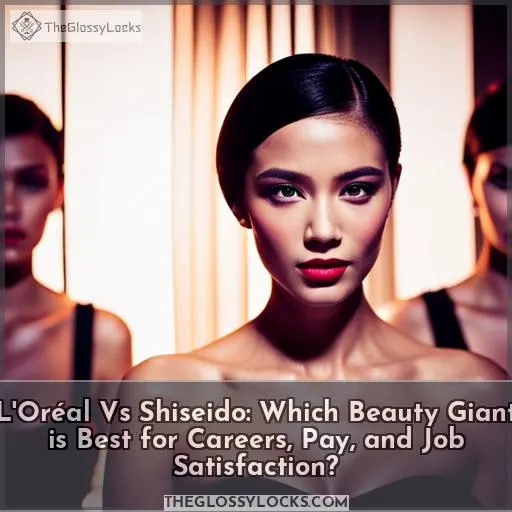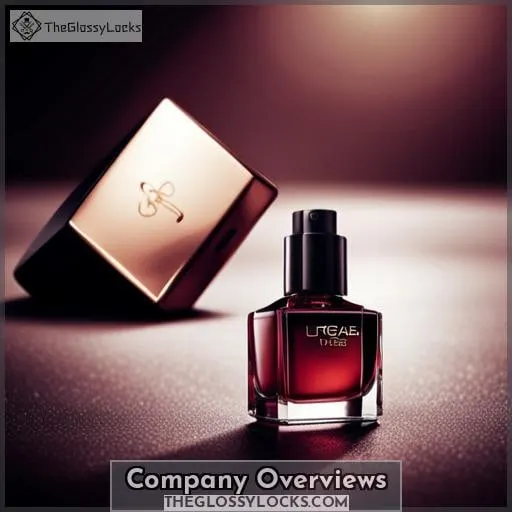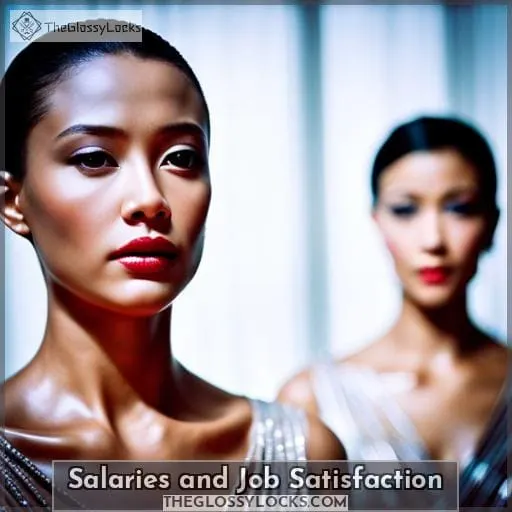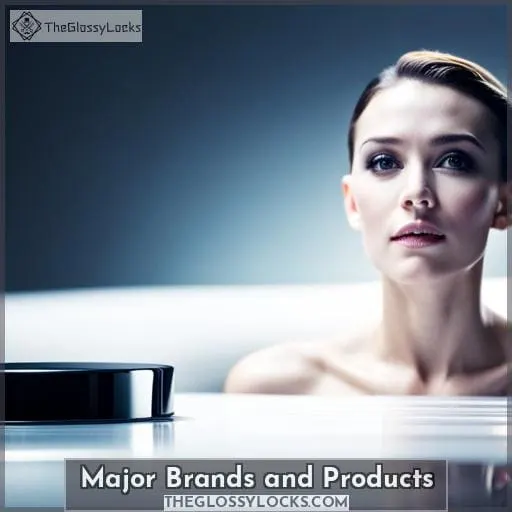This site is supported by our readers. We may earn a commission, at no cost to you, if you purchase through links.

Compare salaries, reviews, and leadership approval ratings to see which behemoth is the best fit for you.
Consider factors like work culture and location as you evaluate these global brands. You want the freedom to pick the company that aligns with your values and offers opportunities to grow.
Do your research to understand where each excels. With an analytical eye and an open mind, you’ll find the beauty brand where you can thrive.
Let this guide shine a light on L’Oreal and Shiseido so you feel confident in your choice.
Table Of Contents
Key Takeaways
- L’Oréal and Shiseido are leading global beauty companies.
- Both companies have positive CEO approval ratings.
- L’Oréal had 28 billion euros in revenue in 2019, while Shiseido had 746 billion yen in net sales in 2020.
- L’Oréal operates in 130 countries, while Shiseido is present in 120 markets.
Company Overviews
L’Oréal and Shiseido are two of the world’s leading beauty companies. L’Oréal reported a revenue of 28 billion euros in 2019, while Shiseido had a total net sales of 746 billion Japanese yen for their fiscal year ended March 2020.
Both companies operate primarily in the cosmetics industry, with L’Oréal having operations across 130 countries worldwide and Shiseido present in over 120 markets globally.
Revenue and Employees
Have you ever wondered what drives two beauty giants like L’Oréal and Shiseido? While they share over $30 billion in annual revenue, L’Oréal employs over 85,000 people worldwide compared to Shiseido’s 48,000.
This fact really illustrates the massive global footprint of L’Oréal versus Shiseido’s more concentrated presence, even though both remain beauty powerhouses. The stark difference in revenue and number of employees shows the scale of operations behind those lovely cosmetics for each company.
It’s quite interesting to think about when you consider the products of two industry leaders side-by-side.
Industry and Locations
You’d find both L’Oréal and Shiseido operating in the beauty industry, though L’Oréal has a stronger global presence across the Americas, Europe, the Middle East, Africa, the Asia Pacific, and India.
- L’Oréal operates in over 150 countries with 68 manufacturing sites.
- Shiseido has over 48,000 employees and 31 production sites globally.
- L’Oréal leads in skincare with a 23.7% market share, compared to Shiseido’s 4.6%.
- Shiseido faces tough regional competition in the Asia Pacific from L’Oréal.
- L’Oréal continues expanding internationally through acquisitions.
Salaries and Job Satisfaction
Employees of both L’Oréal and Shiseido are highly satisfied with their salaries, according to reviews. CEO approval ratings for Nicolas Hieronimus (L’Oréal) and Masahiko Uotani (Shiseido) have been very positive as well.
This article will compare the salary satisfaction at each company in order to gain a better understanding of job satisfaction between the two giants in the beauty industry.
Employee Reviews
Take a deep breath before diving into those raw, authentic reviews that lay bare the real company cultures at L’Oréal and Shiseido. Exhaustive Glassdoor stories detail the frenetic yet creative L’Oréal atmosphere, balanced by the prestigious but rigid Japanese Shiseido hierarchy.
Despite robust international growth, Shiseido employees report frustration with old-fashioned, bureaucratic management inhibiting creativity. Meanwhile, L’Oréal employees relish the breakneck innovation but suffer relentless urgency.
CEO Approval
Do not fret about the CEOs at those beauty giants; their deeds reflect on the brands, not you. Nicolas Hieronimus wins approval by shepherding L’Oréal’s diverse portfolio while positioning the pioneer for China’s burging skincare market expansion.
Though Masahiko Uotani stabilized finances, his leadership rating lags amid Shiseido’s sales slump. CEO satisfaction correlates with strategic vision, so cosmetic giants struggle when executive leadership misaligns with growth opportunities.
Major Brands and Products
When it comes to skincare and haircare, L’Oréal and Shiseido stand out as two of the biggest players in the beauty industry. With internationally recognized brands and continual innovation in products, these companies set the bar for quality and performance across multiple categories.
Skincare
Have you compared the reef-safe serums from L’Oreal and Shiseido to find one with ingredients suitable for your dry skin? Even though their skincare lines may differ, what matters most is finding the right product for your needs.
- Look at the ingredient lists and key actives.
- Read reviews from customers with similar skin types.
- Compare sustainability commitments.
- Consider your budget and pricing.
- Focus on signs of improved skin hydration.
Evaluating and selecting the best skincare products for you requires research, patience, and understanding what works for your unique skin.
Haircare
You’d choose L’Oréal’s Garnier Fructis hair products over Shiseido’s Tsubaki line given their lower price points and comparable quality. Garnier has advanced significantly in haircare innovation, focusing on trending ingredients like argan oil that attract customers.
Although Shiseido offers quality, L’Oréal’s broad brand diversity and market share give consumers better value.
Sustainability Efforts
L’Oreal and Shiseido have both set sustainability goals for 2020 regarding packaging and product formulas. By using recycled materials, biodegradable ingredients, and refill systems, the cosmetic giants aim to reduce their environmental impact.
2020 Goals
L’Oréal and Shiseido have set ambitious 2020 goals to reduce their environmental impact, though the path ahead remains long with winding turns towards a greener future. The two beauty giants aim to cut emissions, water usage, and waste by innovating manufacturing and packaging.
While expanding markets, their acquisition strategies and focus on research and development pursue environmentally-friendly formulas. Engaging employees fosters accountability on the uncertain road towards more sustainable operations.
With each step, the destination comes closer but true transformation requires persistence.
Packaging and Formulas
Both companies are innovating sustainable packaging and formulas that reduce waste without sacrificing quality.
- Packaging made from recycled and sustainably sourced materials
- Formulas free of controversial ingredients
- Focus on natural, ethically sourced ingredients
- Consumer education on sustainability and ingredients
L’Oréal and Shiseido are rethinking packaging and formulas to meet consumer demand for sustainable beauty products. By optimizing packaging and scrutinizing ingredients, they aim to reduce environmental impact without compromising on safety or quality.
Ultimately, these changes give consumers peace of mind about the products they choose for their self-care routines.
Conclusion
It’s clear that when it comes to L’Oréal vs Shiseido, both beauty giants offer competitive salaries and job satisfaction. On average, L’Oréal employees reported an average of $78,640 per year compared to Shiseido’s $85,090, with both companies receiving strong ratings from their employees.
Both CEOs, Nicolas Hieronimus of L’Oréal and Masahiko Uotani of Shiseido, have also been praised for their leadership and commitment to their respective companies. Ultimately, no matter which beauty giant you choose, you can be confident that you will have a rewarding and secure career with competitive pay and job satisfaction.






